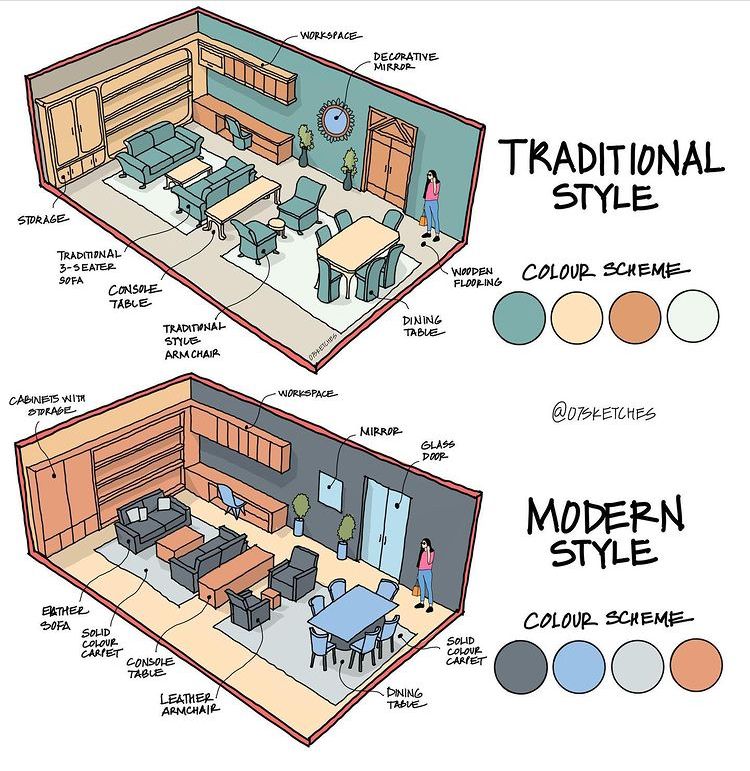Exploring the timeless charm of traditional design and the sleek sophistication of modern living spaces through furniture, color, and function.

When we walk into a room, the first impression is not just about the walls, furniture, or flooring—it is about the story the space tells. Interior design is more than just arranging furniture; it reflects personality, culture, and lifestyle. Two of the most enduring design approaches—Traditional Style and Modern Style—offer contrasting yet fascinating ways to shape the identity of a living space.
A recent comparative layout highlights these differences, showing how every design choice, from sofas to color palettes, can dramatically shift the mood of a home.
1. Traditional Style: Rooted in Warmth and Heritage
Traditional interior design is often described as timeless, classic, and comforting. It borrows elements from history, drawing inspiration from the 18th and 19th centuries, where ornate furniture, rich colors, and symmetry were celebrated.
Key Features in the Traditional Layout:
Furniture: A 3-seater sofa and traditional armchairs dominate the seating area, emphasizing comfort and formality.
Console Table: Placed strategically, it serves both functional and decorative purposes, holding lamps or accessories.
Decorative Elements: Items like a decorative mirror add charm, bringing elegance without overwhelming the space.
Dining Table: A wooden dining set reinforces the warm and inviting aesthetic.
Wooden Flooring: Natural finishes tie the space together, grounding the design with earthy tones.
Color Scheme:
The traditional palette uses greens, creams, peach, and muted orange, all soft and harmonious. These tones create a sense of stability and familiarity, making the room feel like a sanctuary.
Ambiance:
Walking into this room feels like stepping into a family gathering space—inviting, structured, and designed to last. The focus is on coziness and continuity, with an emphasis on detail and craftsmanship.
2. Modern Style: Sleek, Minimal, and Functional
Modern interior design emerged in the early 20th century as a response to industrialization and evolving lifestyles. It prioritizes simplicity, clean lines, and functionality, often with a touch of boldness.
Key Features in the Modern Layout:
Furniture: Sleek leather sofas and armchairs replace ornate wooden pieces. The lines are sharp, geometric, and understated.
Cabinets with Storage: Functionality reigns here. Wall-mounted storage ensures clutter-free living.
Materials: A mix of leather, glass, and metal emphasizes durability and elegance.
Dining Table: Clean designs paired with solid color seating create a sense of balance.
Glass Doors: Transparency adds a contemporary vibe, welcoming natural light while blurring indoor-outdoor boundaries.
Color Scheme:
The palette here uses greys, blues, blacks, and muted browns, creating a bold and sophisticated aesthetic. Unlike the warmth of traditional spaces, modern designs embrace contrast and neutrality, offering flexibility for accents.
Ambiance:
This room embodies a cosmopolitan lifestyle—minimalist, polished, and future-focused. It appeals to those who value efficiency and elegance, creating a professional yet welcoming environment.
3. Furniture: More Than Just Seating
Furniture selection is where the contrast between traditional and modern becomes most apparent:
Traditional spaces use plush, heavy seating meant for long conversations and gatherings.
Modern rooms opt for streamlined, angular furniture, designed to save space and create openness.
Both choices say something about the people who live there: tradition values heritage and comfort, while modernity celebrates progress and innovation.
4. Color Psychology at Work
Colors don’t just decorate a room; they influence mood and behavior.
Traditional colors (green, cream, peach) foster calmness, hospitality, and warmth—ideal for family-oriented homes.
Modern colors (grey, blue, black) encourage focus, elegance, and sophistication—perfect for fast-paced, professional lifestyles.
Designers often recommend choosing colors based not only on style but also on how one wants to feel in a space.
5. Functionality and Lifestyle Fit
Another key difference is how each style serves its users.
Traditional design leans toward aesthetic richness, using furniture and accessories that convey history and meaning.
Modern design is about utility, where every piece has a purpose, often with built-in storage or multipurpose functions.
For example, a modern cabinet system minimizes clutter, while a traditional console table prioritizes display and decoration.
6. Which Style Should You Choose?
The choice between traditional and modern depends on personal preference, lifestyle, and context:
Choose Traditional if:
You value warmth, family gatherings, and timeless aesthetics.
You prefer spaces that feel cozy and heritage-rich.
You love detail, pattern, and craftsmanship.
Choose Modern if:
You want clean lines, efficiency, and a clutter-free lifestyle.
You live in urban spaces where minimalism works best.
You appreciate sleek finishes and understated elegance.
Some homeowners even blend both styles, a trend known as Transitional Design, where the comfort of tradition meets the sleekness of modernity.
7. Beyond Style: The Emotional Connection
Ultimately, interior design isn’t about rules; it’s about how a space makes you feel. A traditional room may remind you of childhood dinners with family, while a modern room may inspire focus and productivity.
In this way, design is personal storytelling—using colors, furniture, and layout as the language.
Conclusion: The Evolution of Home Spaces
As lifestyles evolve, so do design choices. Traditional style remains a tribute to heritage, while modern style celebrates simplicity and progress. Both, however, share one common goal: to make a house feel like home.
This comparative layout of Traditional vs Modern interiors is more than a design exercise—it’s a reflection of human values across time. Whether you gravitate toward the cozy embrace of tradition or the streamlined sophistication of modern living, your choice defines how you experience daily life.
Because in the end, design isn’t just about how a room looks—it’s about how it makes you live.